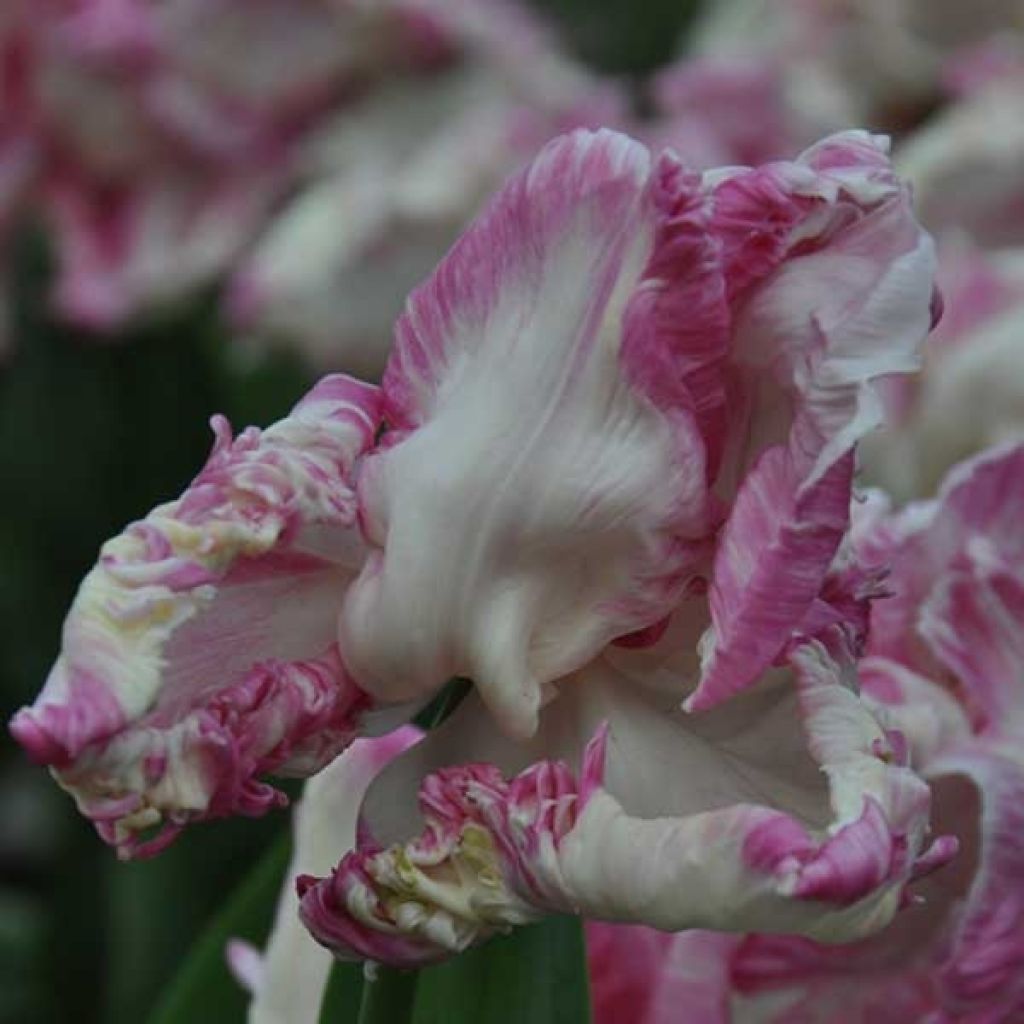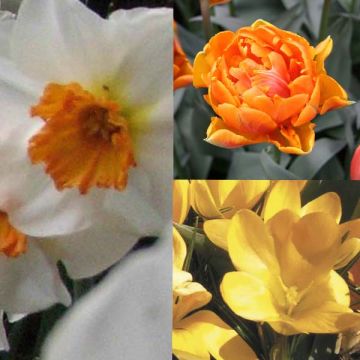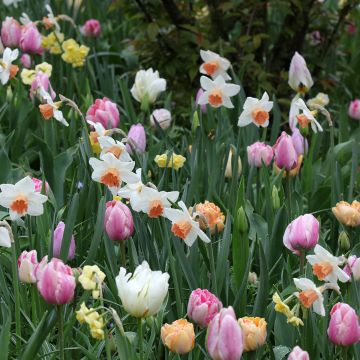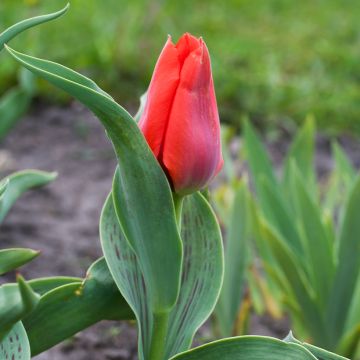

Tulipe Perroquet Weber s Parrot
Tulipa Weber's Parrot - Tulipe Groupe Perroquet
Tulipa Weber's Parrot
Beautiful tulip! So charming.
annick, 06/07/2015
Home or relay delivery (depending on size and destination)
Schedule delivery date,
and select date in basket
This plant carries a 6 months recovery warranty
More information
We guarantee the quality of our plants for a full growing cycle, and will replace at our expense any plant that fails to recover under normal climatic and planting conditions.
Does this plant fit my garden?
Set up your Plantfit profile →
Description
The Parrot Tulip 'Weber’s Parrot' is a variety of flamboyant and terribly original spring bloom, sought after for its large crinkled and undulate flowers in shades of cream, white, purple-pink, and hints of green, evoking the vibrant plumage of an exotic bird. It displays a flexible yet sturdy habit, with flower stems around 40 to 45 cm tall, elegantly supporting its opulent corollas. Suitable for sunny or lightly shaded spots, it thrives in well-drained, fertile, and moist soil, whether in pots or in the ground. Perfect for borders or vases, it extends the tulip season while adding an artistic flair to spring displays.
The Parrot Tulip 'Weber’s Parrot' belongs to the Liliaceae family, Parrot group, cultivars derived from mutations of late single and Triumph tulips. This cultivar differs from the typical Tulipa gesneriana species with its extravagant, fringed, and undulate-petaled flowers, reminiscent of a parrot’s exoticism. It has a robust, upright habit, with sturdy stems of 40 to 45 cm when grown in the ground. Its spring growth is rapid with the first warm spells. The plant does not produce visible offsets, but bulblets may appear after several seasons. The flowers are large, with creamy petals edged in green and purple-pink, featuring deeply undulate and decorative margins. They bloom from mid-April to May, opening widely in full sun to reveal a contrasting centre. The foliage is deciduous, consisting of broad, lanceolate, medium-green leaves that fade after flowering. The stem is fleshy, providing strong support for the ample corolla. Fun fact: Parrot tulips, originating from mutations in 18th-century France, were prized the following century for their lush, feather-like appearance. Parrot tulips boast excellent hardiness.
The tulip 'Weber’s Parrot' fits perfectly into a theatrical composition where plants become painterly gestures. In a partially shaded border with soft textures, it pairs beautifully with apricot-toned 'Replete' daffodils and the dark counterpoint of 'Black Parrot' tulip. Placed in delicate strokes among clumps of purple heucheras or fine ferns, it lends the scene a controlled visual tension, where each petal’s undulation seems hand-painted. In containers, it demands a minimalist backdrop to let its baroque blooms take centre stage, creating surprise within an orderly structure.
Report an error about the product description
Plant habit
Flowering
Foliage
Botanical data
Tulipa
Weber's Parrot
Liliaceae
Tulipa Weber's Parrot
Cultivar or hybrid
Planting and care
For optimal spring flowering, it's best to plant the 'Weber's Parrot' parrot tulip in a sunny spot between October and December. It can also be placed in a partially shaded location. Plant the bulbs as soon as possible in light, fertile, well-drained soil, loosened deeply to 15 cm (cover the bulbs with twice their height of soil). Space the bulbs 10 cm apart, ensuring they don't touch to create a mass effect; cut the flower stems after flowering. Allow the leaves to dry completely before cutting them.
Planting period
Intended location
Care
-
, onOrder confirmed
Reply from on Promesse de fleurs
Similar products
Haven't found what you were looking for?
Hardiness is the lowest winter temperature a plant can endure without suffering serious damage or even dying. However, hardiness is affected by location (a sheltered area, such as a patio), protection (winter cover) and soil type (hardiness is improved by well-drained soil).

Photo Sharing Terms & Conditions
In order to encourage gardeners to interact and share their experiences, Promesse de fleurs offers various media enabling content to be uploaded onto its Site - in particular via the ‘Photo sharing’ module.
The User agrees to refrain from:
- Posting any content that is illegal, prejudicial, insulting, racist, inciteful to hatred, revisionist, contrary to public decency, that infringes on privacy or on the privacy rights of third parties, in particular the publicity rights of persons and goods, intellectual property rights, or the right to privacy.
- Submitting content on behalf of a third party;
- Impersonate the identity of a third party and/or publish any personal information about a third party;
In general, the User undertakes to refrain from any unethical behaviour.
All Content (in particular text, comments, files, images, photos, videos, creative works, etc.), which may be subject to property or intellectual property rights, image or other private rights, shall remain the property of the User, subject to the limited rights granted by the terms of the licence granted by Promesse de fleurs as stated below. Users are at liberty to publish or not to publish such Content on the Site, notably via the ‘Photo Sharing’ facility, and accept that this Content shall be made public and freely accessible, notably on the Internet.
Users further acknowledge, undertake to have ,and guarantee that they hold all necessary rights and permissions to publish such material on the Site, in particular with regard to the legislation in force pertaining to any privacy, property, intellectual property, image, or contractual rights, or rights of any other nature. By publishing such Content on the Site, Users acknowledge accepting full liability as publishers of the Content within the meaning of the law, and grant Promesse de fleurs, free of charge, an inclusive, worldwide licence for the said Content for the entire duration of its publication, including all reproduction, representation, up/downloading, displaying, performing, transmission, and storage rights.
Users also grant permission for their name to be linked to the Content and accept that this link may not always be made available.
By engaging in posting material, Users consent to their Content becoming automatically accessible on the Internet, in particular on other sites and/or blogs and/or web pages of the Promesse de fleurs site, including in particular social pages and the Promesse de fleurs catalogue.
Users may secure the removal of entrusted content free of charge by issuing a simple request via our contact form.
The flowering period indicated on our website applies to countries and regions located in USDA zone 8 (France, the United Kingdom, Ireland, the Netherlands, etc.)
It will vary according to where you live:
- In zones 9 to 10 (Italy, Spain, Greece, etc.), flowering will occur about 2 to 4 weeks earlier.
- In zones 6 to 7 (Germany, Poland, Slovenia, and lower mountainous regions), flowering will be delayed by 2 to 3 weeks.
- In zone 5 (Central Europe, Scandinavia), blooming will be delayed by 3 to 5 weeks.
In temperate climates, pruning of spring-flowering shrubs (forsythia, spireas, etc.) should be done just after flowering.
Pruning of summer-flowering shrubs (Indian Lilac, Perovskia, etc.) can be done in winter or spring.
In cold regions as well as with frost-sensitive plants, avoid pruning too early when severe frosts may still occur.
The planting period indicated on our website applies to countries and regions located in USDA zone 8 (France, United Kingdom, Ireland, Netherlands).
It will vary according to where you live:
- In Mediterranean zones (Marseille, Madrid, Milan, etc.), autumn and winter are the best planting periods.
- In continental zones (Strasbourg, Munich, Vienna, etc.), delay planting by 2 to 3 weeks in spring and bring it forward by 2 to 4 weeks in autumn.
- In mountainous regions (the Alps, Pyrenees, Carpathians, etc.), it is best to plant in late spring (May-June) or late summer (August-September).
The harvesting period indicated on our website applies to countries and regions in USDA zone 8 (France, England, Ireland, the Netherlands).
In colder areas (Scandinavia, Poland, Austria...) fruit and vegetable harvests are likely to be delayed by 3-4 weeks.
In warmer areas (Italy, Spain, Greece, etc.), harvesting will probably take place earlier, depending on weather conditions.
The sowing periods indicated on our website apply to countries and regions within USDA Zone 8 (France, UK, Ireland, Netherlands).
In colder areas (Scandinavia, Poland, Austria...), delay any outdoor sowing by 3-4 weeks, or sow under glass.
In warmer climes (Italy, Spain, Greece, etc.), bring outdoor sowing forward by a few weeks.









































